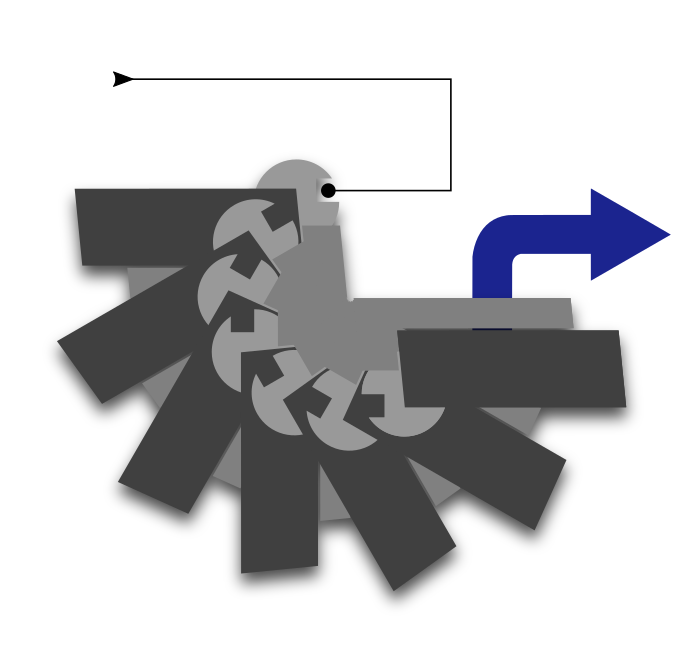Audio systems can be counted on to be deterministic in every practical way, but you can’t always count on them to be the same system.
Please Remember:
The opinions expressed are mine only. These opinions do not necessarily reflect anybody else’s opinions. I do not own, operate, manage, or represent any band, venue, or company that I talk about, unless explicitly noted.

 Want to use this image for something else? Great! Click it for the link to a high-res or resolution-independent version.
Want to use this image for something else? Great! Click it for the link to a high-res or resolution-independent version.In my experience, audio systems are deterministic creatures at the practical level.
That is to say, giving the system an input results in getting an output which has always been transformed in the same way. Introduce an input into a perfectly linear system which runs through a +6 dB gainstage, and you can count on getting your input, +6 dB, at the output. Give your input to a system with a nonlinear transfer function and a +6 dB gainstage, and you can be confident that the other end of the system will spit out your input signal, plus the filtering of the transfer function, and +6 dB of level.
I am, of course, excluding noise.
Electronic self-noise, if you’re being really picky, displays “random” behavior. The overall level and frequency content is statistically predictable, but the exact output at any given instant can’t be precisely foreseen. If you include the noise in your description of the output, then yes, you can argue that a sound system is non-deterministic.
But, let’s be real. At a mental level, whether we’re listening to a system or describing its behavior, we subtract the noise. There’s also the whole matter of best practices dictating that systems should be run in such a way that the noise is insignificant when compared to the signals, which makes that mental subtraction trivial.
Anyway – as far as I can tell, audio systems are deterministic in every way that really matters.
This, and a somewhat surprising component of it, can inform our concepts of troubleshooting.
Apparent Non-Determinism Makes Life Difficult
Notice that I said, “apparent.”
See, I was originally going to write this article by saying that a sound rig displaying non-deterministic behavior is one of the toughest things to troubleshoot. However, in thinking about things more fully, I’ve come to the conclusion that audio setups aren’t really capable of being non-deterministic. They can SEEM to become non-deterministic, but they aren’t actually. What truly happens is that you expected one particular system, but actually have something else.
Let’s say that you set up a FOH PA system. Everything is working nicely. You give it an input, and you get the output you expect from the loudspeakers. Groovy.
Then, when you’re not looking, somebody accidentally pulls the connection that links the console with all the downstream bits. Unaware of this, you return to FOH control and give the system an input. The output is silence. It’s not the output you expected, but the system hasn’t entered a non-deterministic state. Rather, what you have is a different system: A system that ends at the console. A mixing console that can’t pass its signals to an output transducer has an acoustical gain of 0. (Not 0 dB! A gain of 0. The signal is multiplied by 0. Any signal multiplied by 0 is 0.) The system, in truth, is both entirely deterministic and highly predictable. Any input to it results in no acoustical output.
So, no, the rig isn’t non-deterministic – it’s just not the system you expected to be in place. There is a reason that the setup is not behaving as expected, and that reason (a disconnected cable, in this case) can be isolated and corrected.
I recognize that this is small comfort to those of you, including me, who have been faced with intermittent problems. Intermittent failures are the hardest to fix, and the most nail-biting to endure, because you’re up against something that APPEARS to be non-deterministic. The output from a given input becomes unpredictable. You might be just fine for hours, and then things go very wrong, and then you’re fine for a few minutes, and then something else happens, and your blood-pressure goes through the roof.
Basically, you’re trying to debug multiple systems without knowing which system you’re currently debugging. (Good luck with that.) This is why I have been known to breathe a sigh of relief when a rig “breaks,” and has the decency to then STAY broken. When that happens, I only have to troubleshoot one system; A deterministic system which either has no output, or some output which is obviously and predictably not what I want.
If you’re faced with an audio setup that appears to be doing things at random, what you really have is – very likely – more than one system. Those systems are trading places at unpredictable times. Every one of those systems is deterministic, so what you have to do is stop all systems but one from manifesting themselves. If you can directly get that one system to be the setup that gives you the desired output, that’s great. If you can’t, though, that’s really okay. Even if the output isn’t what you ultimately want, causing your assemblage of gear to settle into one stable state will give you the leverage necessary to figure out what’s wrong and fix it. If the system seems to be non-deterministic, do what you have to do to make it appear to be as deterministic as it actually is. You’ll be back in control, and control is what you need in order to get things working again.